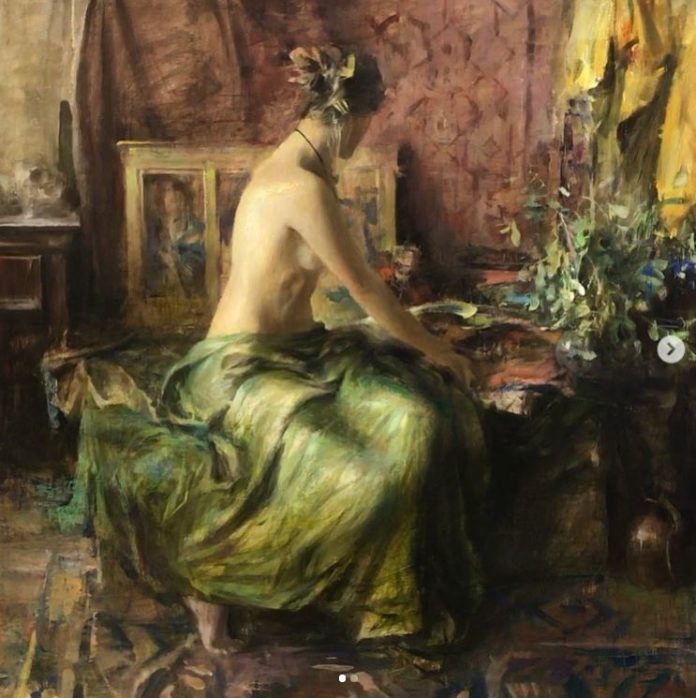
With a painting that honors a “return to classical romanticism,” Quang Ho shares his thoughts on glazing.
Cherie Dawn Haas: You’ve said that this painting symbolizes “A return to classical romanticism.” Can you expand on this?
Quang Ho: My art training was mostly the direct painting approach. At the time (early 1980s) there was no one teaching this grisaille or glazing method, so I didn’t have access to the understanding of what the old masters employed before the direct painting method. Once I got a little insight into it, I went back to the museums and studied carefully and realized how they almost all utilized this tool. Being the explorative painter that I am, I dove into finding out what fun I can have with it.
CDH: In what ways is this work a “glazing experiment”?
QH: I learned a bunch from it. First of all, it made painting a whole lot simpler and easier. Focusing on just good drawing, value, and composition without the extra difficulty of color accuracy at the start of a painting makes it so much more accessible.
With a solid underpainting, glazing and giving it color is a breeze. There’s definitely an art there, but the options open up greatly as to color choices. If I don’t like something, I can wipe it off and rework the area right away.
It took me over ten different tries and experiments to figure out what I can and can’t do, what I thought it was, and what the limitations are. What I found is that the great master works that used to confound me are all of a sudden very achievable. It’s very exciting, of course.
I want to take it further by combining glazing with direct painting. Glazing is now just a start, and I can work and rework directly on it and glaze again. It’s just another tool to use.
I’ve found that there are as many different glazing mediums as there are paint brand names, and in my experience most glazing mediums will work. I’ve played with Liquin to Galkyd to Neo Megilp to stand oil. They all do more or less the same thing. The old masters have used lead whites with anything from greenish umbers to siennas to just black and grays to achieve the underpainting (grisaille). I’ve experimented with adding just a touch of color to this first process, and that adds a little more dimension to the painting. I am still experimenting with the glazes being transparent colors at first, then adding more opaque colors as I need more punch later. At the glazing stage, it’s necessary to have very soft brushes to apply the broader glazes. You’d want to hide the brush strokes of the glazes as much as possible.
CDH: Can you share some of your insights about the composition of this piece?
QH: The composition is from a painting session I did over 15 years ago; I took some photos at that time. I have always loved the intimate feeling of the model in this environment. When I started playing with glazing, I went back and looked at some old reference material and this jumped back out at me.
The key to this composition is that the shadow is holding the entire painting together. It’s treated very simply (with few color changes) and has very soft edges, implying a soft light coming in from the left.
View this post on Instagram
Took it a step further. Now it’s done. Going to the Wooleroc Museum show mid October.
CDH: Anything else you’d like to add?
QH: For me, there is no one way of painting — there are no particular methods I’m married to. It’s about gathering as much information and ability as possible and then allowing myself to follow visual impulses and ideas, allowing each one to tell me how they might be coaxed out of the canvas. Glazing is a great set of tools for adjusting values and colors in a hurry. That is what I find so wonderful about it.
View this post on Instagram
In progress. 36×24. Trying this composition again from a much smaller attempt over five years ago.
Connect with Quang Ho:
Website | Instagram
Listen to Eric Rhoads interview Quang Ho on the PleinAir Podcast:




